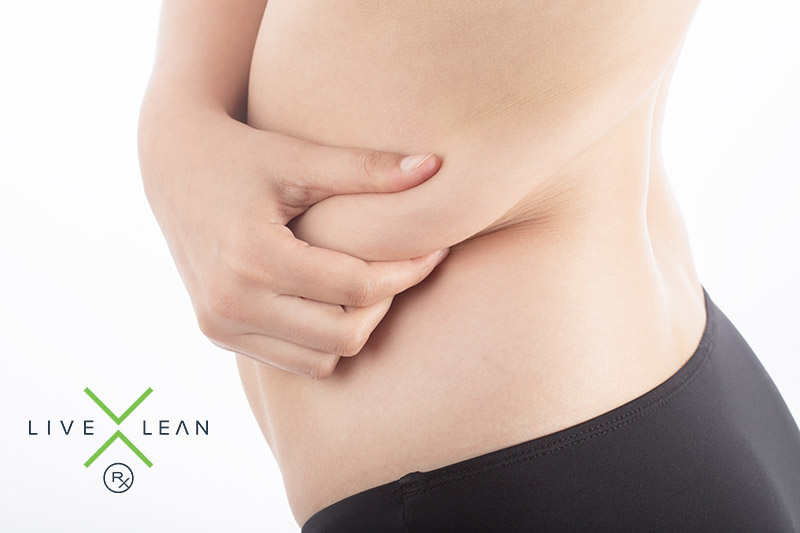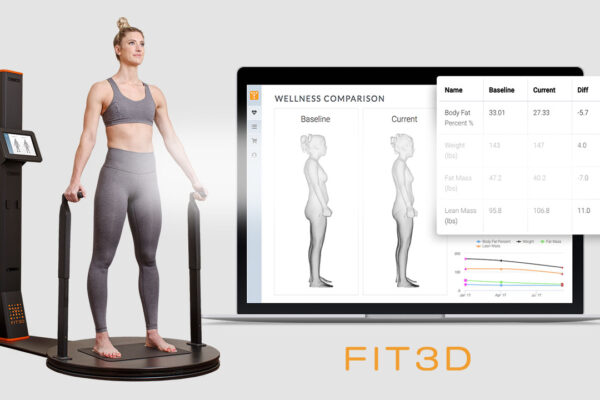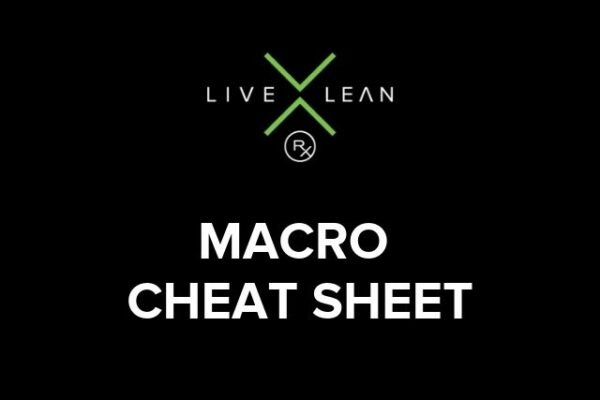There are several ways to measure or estimate body fat, and we’re going to talk about those. But first, let’s talk about why you should measure your body fat.
Although we talk often about body fat, the amount of fat tissue in your body is only one part of your body composition. Your body is made of many kinds of tissues, but each can be categorized as lean tissue, bone, or body fat. When we measure how much lean tissue, bone, and body fat a person has we are measuring their body composition. At Live Lean Rx Houston, your DEXA scan report tells you how much of each tissue type you have in both pounds and as a percentage of your overall body composition.
Let’s look at an example where a person is:
150 pounds
6 pounds of the person’s body weight is bone.
110 pounds of the person’s body weight is lean tissue.
35 pounds of the person’s body weight is fat tissue.
By dividing the amount of body fat (35 lbs.) by the total body weight (150 lbs.) we can determine that this person is at 23.3% body fat. This is considered average for men and fairly lean for women because women need more essential body fat than men.
Why Should I Measure My Body Composition?
Looking in the mirror and standing on your bathroom scale can help you monitor changes, but this can’t tell you what changes are really happening. Maybe you’ve found yourself in a weight loss plateau and the scale won’t budge! The real answer is in understanding what you’re made of. A DEXA scan might show that you gained muscle and lost fat over time. This would be excellent progress for someone looking to lose fat or build muscle, but it’s progress the scale can’t report.
Understanding your body composition does more than just monitor the effectiveness of your diet and exercise programs, though. Researchers seem to agree that excess body fat increases a person’s risk of diseases like high cholesterol, diabetes, and heart disease. However, you don’t have to be obese or even overweight to have excess body fat! A person can have a normal body weight and even appear slim but still carry an unhealthy amount of body fat inside. Relying on the scale could leave you with unidentified risks for serious health issues.
Speaking of risks, part of understanding your body composition should include an understanding of how much visceral fat you have. There are multiple types of fat in our bodies. Most people think of the type of fat that can make us look (and feel) heavy. This is subcutaneous fat that our bodies store for fuel under our skin and you can find this in every part of the body. Visceral fat is another type of fat that is stored inside the abdominal wall instead of under the skin and coats internal organs. Research shows that in high amounts, visceral fat increases your risk for obesity-related health issues.
So how do you measure body fat? There are a variety of tools and methods available to estimate or measure body fat. Let’s talk about the pros and cons of each.
Skinfold Measurements with Calipers
Estimating body fat my measuring skinfolds with calipers is a quick and affordable method of body fat estimate. Anyone can get calipers for about $10! There are some important disadvantages, though. To begin with, the idea of skinfold measurement came from the assumption that measuring fat under the skin (subcutaneous) in certain locations would allow a person to mathematically deduce how much fat is in the entire body. However, individuals store both subcutaneous and visceral fat differently and the equations for estimating body fat based on skin fold measurements don’t account for these differences. Beyond the variance of individuals, the accuracy of skinfold measurements depends heavily on the person using the calipers to know exactly where to place the calipers and how much skin to pinch for, a skill few people have the training and experience to have developed.
Bioelectrical Impedance Analysis – BIA (InBody)
Bioelectrical impedance analysis (BIA) devices send a small electrical charge through a body and measure how long it takes the charge to travel from one point to another. If you’ve estimated your body fat using a handheld device, a “smart scale,” an InBody, or a device in your local gym or supplement shop, then you’ve likely used a BIA device. BIA devices will typically estimate how much lean tissue and body fat you have but they won’t estimate your bone mass or visceral fat. We believe BIA devices may be a good way to track trend between true body fat measurements but there are some shortcomings to consider when using BIA.
First, BIA devices are highly susceptible to changes in hydration levels in a person. Muscle conducts electricity better than body fat because it has more water content, but that is only true in a normally hydrated person. Using a BIA device when dehydrated will mean there is less fluid in the muscle to transmit the electrical charge, which the BIA device is likely to interpret and report as less lean tissue. Another disadvantage is that BIA devices only estimate body fat and muscle in certain parts of the body and then use equations to estimate for the total body composition. As with skinfold measurements, these equations don’t account for the unique ways a person can carry body fat and muscle in parts of the body not estimated. All these considerations can lead to variable and inaccurate results. In our experience, extremely lean athletes tend to find that BIA devices overestimate their body fat percentage while those with excess body fat report that BIA devices underestimated their body fat percentage.
If you choose to use BIA to track trends over time, then we recommend you become familiar with the user instructions for the specific device you use. Avoid testing after workouts, when your muscles have less fluid and glycogen (fuel stored in muscles) and try to test under the same conditions each time.
Hydrostatic Weighing (Under Water Weighing)
You may have heard of underwater weighing – that’s hydrostatic weighing. It’s a technique for estimating body composition based on the idea that body fat is buoyant. Lean tissue and bone are denser than water while fat tissue is less dense than water. This means that a person with more body fat will weigh less underwater than on dry ground and a person with more muscle will weight more underwater than on dry ground.
Hydrostatic weighing is considered accurate. Hydrostatic weighing is based on a scientific law of buoyancy called the Archimedes principle. It is a true and accurate calculation of how much water is displaced, or moved, by an object when it is submerged underwater. However, like other methods, the technique relies on assumptions to estimate bone density and lean mass – values that vary based on age, gender, and ethnicity. Another challenge to the test is accessibility and inconvenience. There are few places to request a hydrostatic weighing and the test requires being immersed underwater at least three times for an accurate result. This isn’t a test most of us could schedule over a lunch break!
Air Displacement Plethysmography (BodPod)
Since plethysmography probably isn’t part of your everyday vocabulary, then let’s stop to talk about it (whether you try to pronounce it is up to you!). A plethysmograph is a machine used to measure changes in volume (the amount of space inside) of an organ or a body. In air displacement plethysmography a machine measures the amount of air displaced by the body. You might have heard of the BodPod body composition test – this is air displacement plethysmography! To measure your body fat with a BodPod, you must wear tightly fitted clothes that won’t trap air, such as spandex or a swim suit, and a swim cap. You then sit in an egg-shaped machine, or pod, and the amount of air displaced by your body is used in an equation to estimate your body composition. This method of body fat testing is about as accurate as hydrostatic weighing but has shown limited accuracy when attempting to determine changes over time, a primary consideration when choosing an assessment method for athletes. It is reasonably available and affordable, although changing into spandex may be slightly inconvenient.
Dual Energy X-Ray Absorptiometry (DEXA)
DEXA is obviously our preferred method of measuring body composition, which is why we chose it as the backbone of the Live Lean Rx Houston business. DEXA is widely considered the Gold Standard in body composition measurement. DEXA scans are accurate enough to tell you within one tenth of an ounce how much lean tissue, bone, and body fat (both subcutaneous and visceral fat!) is in your body. During a DEXA scan, you lay still on your back on a machine called a bone densitometer for about 6 to 10 minutes. Bone densitometers are the exact same machines used to measure bone density in clinical settings. The machine passes a low energy x-ray beam through your body while an arm passes over your body and collects the x-rays. Because different types of tissue absorb x-ray at different rates, the machine and software can identify exactly how much fat, bone, and muscle you have in every part of your body. This means the machine can even tell you whether your muscles are symmetrical across your right and left sides of the body and can measure your visceral fat to help you monitor heath risks as you work to accomplish your goals.
The most obvious disadvantage of a DEXA scan is that it introduces a small amount of radiation. The dose is so low, however, that it can be compared to an airport body scan, dental x-rays, or a cross-country flight. Additionally, some inaccuracy can be introduced during repeat scans if you eat a heavy meal before a scan, if you test under different conditions each time (for example, fasted at your first test and after a meal the next time), or if you aren’t positioned similarly for each test. We review your scan history and spend time helping you make small adjustments to your position at each test to ensure the most accurate result possible.
Historically, cost and availability of DEXA scans have been another disadvantage, but we’re working to change that by offering scans in the heart of Clear Lake at competitive rates (we even accept HSA/FSA cards).
Whether you choose DEXA scans or another body fat measurement option, we recommend you test as soon as possible once you set a health or fitness goal and continue monitoring regularly. Testing on a regular schedule helps you monitor your progress meaningfully and make sure your program is working for you.





Recent Comments